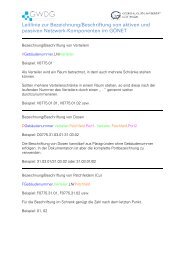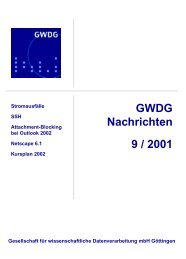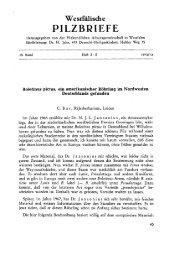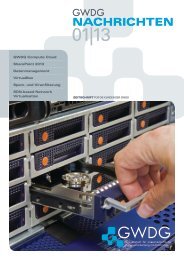Forschung und wissenschaftliches Rechnen - Beiträge zum - GWDG
Forschung und wissenschaftliches Rechnen - Beiträge zum - GWDG
Forschung und wissenschaftliches Rechnen - Beiträge zum - GWDG
Erfolgreiche ePaper selbst erstellen
Machen Sie aus Ihren PDF Publikationen ein blätterbares Flipbook mit unserer einzigartigen Google optimierten e-Paper Software.
Simplicity is a boolean property. So the answer is either “yes” or “no”,<br />
encoded as 1 or 0, respectively. The output says that P is, indeed, simple.<br />
Asamatteroffact,polymake knows quite a bit about standard constructions<br />
of polytopes. So you do have to type in your 3-cube example. You can<br />
use the following command instead. The trailing argument 0 indicates a cube<br />
with 0/1-coordinates.<br />
> cube cube.poly 3 0<br />
3.2 Visualizing a Random Polytope<br />
But let us now try something else. How does a typical polytope look like?<br />
To be more precise: Show me an instance of the convex hull of 20 randomly<br />
distributed points on the unit sphere in R3 . This requires one command to<br />
produce a polymake description of such a polytope and a second one to<br />
trigger the visualization. Again there is an implicit convex hull computation<br />
going on behind the scenes. On the way a complete combinatorial description<br />
of the polytope is obtained.<br />
> rand_sphere random.poly 3 20<br />
> polymake random.poly VISUAL<br />
polymake’s standard tool for interactive visualization is JavaView by<br />
Polthier and others [22] For instance, it allows you to rotate or zoom into your<br />
polytope. Here is a sequence of snapshots.<br />
Fig. 2: Interactive visualization of a random polytope with JavaView: Three snapshots.<br />
3.3 Linear programming<br />
Polytopes most naturally appear as sets of feasible solutions of linear programs.<br />
Consider the following example.<br />
A linear inequality a0 + a1x1 + ...adxd ≥ 0 is encoded as the inward<br />
pointing normal vector to the corresponding affine hyperplane (of suitable<br />
length). This is what polymake uses: the former inequality is represented<br />
as the vector (a0,a1,...,ad). Our linear program in polymake’s format<br />
41
















